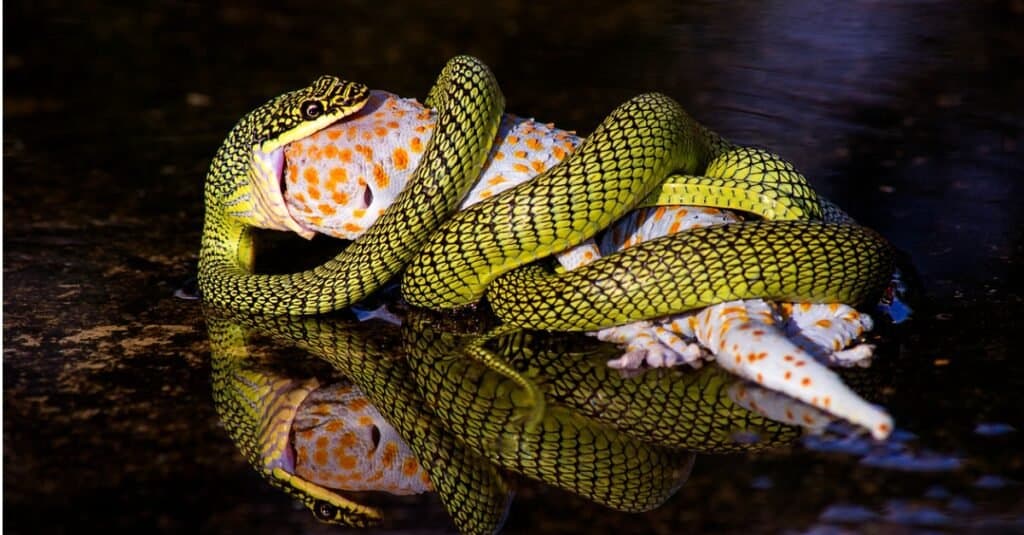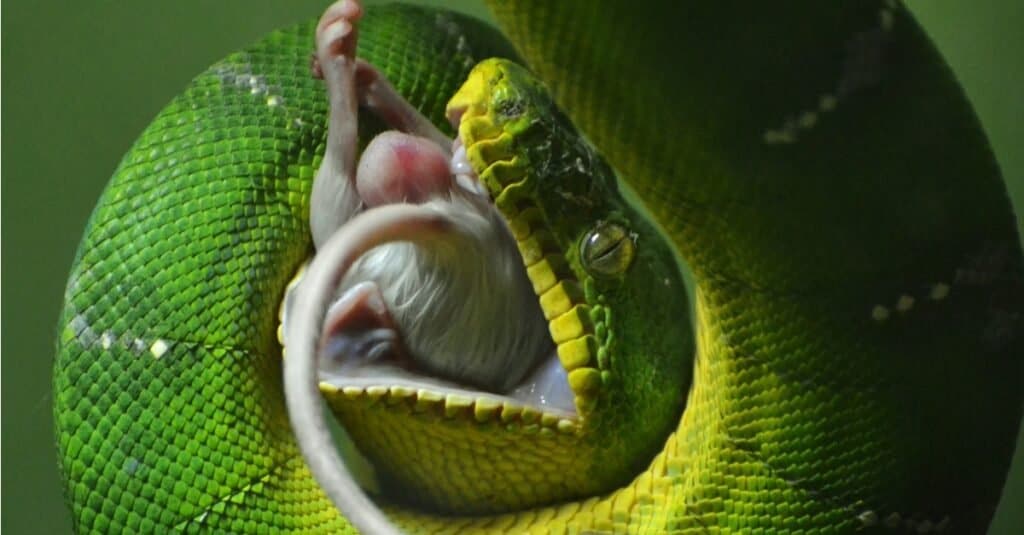Key Point
- Some snakes need to eat every few days, but some can go for months between meals.
- Snakes in captivity shouldn’t be restricted water intake for longer than a week.
- A snake’s upper and lower jaw don’t detach from one another; they have stretchy ligaments that hold things together.
Snakes in popular culture are often treated as voracious and alien creatures, but they’re vital to maintaining healthy ecosystems. They can open their mouths impossibly wide, which may look terrifying. But what may seem frightening to us is a sign of evolutionary success.
Natural selection caused the snake to lose the four legs its ancestors had, but serpent species have now come to represent a third of the total number of reptile species. On the surface, the snake takes several complex biological processes and reduces them to their most basic parts for the sake of accommodating its primitive body shape. But that’s also forced snakes to adopt some truly creative characteristics to help them perform tasks that creatures like humans and chimps take for granted.
Due to some of these unique alterations, some snakes can go a long time without needing a meal. But the whys and the hows are the important part of the answer. This is how some snakes have developed the ability to go for long periods without eating and how circumstances led to them becoming this way.
How Snakes Consume Their Prey

©iStock.com/tikephoto
The open jaw of a snake might be terrifying up close, but it’s also a reminder that we’re lucky to be able to chew. All snakes are ambush predators, but they’ve developed three primary methods for consuming prey, each of varying effectiveness depending on the size, nature, and environment of a species.
A snake that won’t eat for a long time will eventually starve to death, so it’s important to make sure your snake is otherwise healthy if it goes on a food strike. Infant snakes, however, can only go about a week without food before their bodies begin to struggle. It’s important for snakes to eat on a regular basis as babies, but as they reach adulthood, their bodies generally become less needy for food.
Venom is perhaps the most effective. The needle-like fangs of snakes may not be great for ripping and tearing at an animal’s body, but most venomous snakes’ fangs are effective at delivering venom. Once the venom does its work — by either killing or paralyzing prey — the snake can get to work swallowing it. In some cases — such as with pit vipers like rattlesnakes — the venom might even begin the process of digesting a prey animal’s insides to make it easier on the snake. However, this has not been proven.
But only about one in five snake species is venomous.
Constrictor species are by far the most common, as they use various methods to incapacitate their prey before swallowing. Others are simple, effective predators that can reach out and swallow prey whole. For constrictors and venomous snakes, the real chore comes from actually swallowing their prey.
Unable to rip or cut the flesh, these snakes have to open their jaws as wide as they can and slowly wiggle their lower jaws underneath the prey animal, like lining up a forklift. A snake’s upper and lower jaw don’t detach from one another, but it can open up to four times the width of a snake’s body. Their skin is similarly designed for flexibility and to stretch around the food item.
How Snakes Expend Their Energy
Wrapping your head around how these legless reptiles can go so long without food requires an understanding of how and why different types of animals require dramatically different amounts of energy. While the organisms that cover this planet take incredibly diverse forms, the process of natural selection that underlies everything is driven by the simple arithmetic of energy expended and energy consumed.
As warm-blooded animals, humans and all other mammals can maintain their body temperature internally. While this allows mammals to be more active than their reptilian counterparts, this active metabolism is also costly in terms of energy. The cheetah is the world’s fastest land mammal, but properly maintaining that body means eating over six pounds of meat a day.
Reptiles can afford to be more energy efficient because they use an external power source. Natural heat and light get them active and moving. Most snakes’ bodies work at optimum effectiveness between 80 and 90 degrees Fahrenheit. Their lower metabolic rate means they need less food. The average reptile requires only 20 to 25% of the nutrient intake of a mammal.
It’s an effective way to succeed because it allows them to thrive under difficult circumstances. The opportunities might not be sustainable for more lethal but also more energy-dependent mammal predators. It also allows them to effectively live through cold weather by brumating — the reptile answer to hibernation. During brumation, they do not eat and may only drink a few times until the weather warms.
How Snakes Digest Their Prey
Being able to disable their prey with a single venomous bite allows these ambush predators to hunt with lowe risk to their safety. It also reduces their energy expenditure, but digesting a meal is a very costly process. The Burmese python is an extreme but representative example. Once a fresh meal is carried into the stomach and begins being broken down, this serpent’s body fluctuates wildly.
Their metabolism will accelerate up to 44 times its original rate. Additionally, their organs can double in size, maximizing their digestion process efficiency. This isn’t the norm, but it’s impressive when you consider that most snake species will typically eat a quarter of their body weight in a single sitting. Some pythons are voracious eaters and have eaten up to 95% of their body weight in one meal.
Human beings may need three square meals a day, but a snake doesn’t. It can simply gorge once and then take a long nap while digesting it. The actual digestion process varies depending on the size of the snake, the surrounding temperature, and the meals’ size. Snakes can finish digesting smaller meals in a few days. However, it could take an anaconda weeks to fully digest a capybara.
There are dangers involved with longer and more difficult digestion processes. Larger game is more likely to have horns, fangs, or claws that can pierce an internal organ and kill the snake. They need to be exposed to heat to properly digest, but they’re also vulnerable targets as long as they’re engorged with their meal.
And while the digestive acids being used are potent, a serpent’s organs are in a race against their prey. If it can’t dissolve the prey faster than the corpse can decompose, the snake’s meal could poison it, grow inside its stomach, or trigger the explosion of gases. It can be a costly risk, but a big meal dramatically increases the amount of time that a snake can go without eating.
The Average Snake’s Dietary Schedule

©iStock.com/mjf795
In terms of how often and how much food the average snake needs, it can vary tremendously between different species. Researchers have identified both frequent and infrequent feeders, with the latter exhibiting the behavior of ball pythons demonstrated for growing their organs to assist with digestion.
Baby snakes and frequent feeders might eat about twice a week, while infrequent feeders may comfortably go without eating for a couple of weeks at a time. In extreme cases, it might be weeks before the last meal is even digested.
As reptiles, snakes are also capable of a state called brumation which allows them to sink into a deep torpor during colder months. It is a critical survival method when prey is scarce during winter. Plus, with a lack of sunlight and heat, most snakes are ill-equipped to hunt anyway.
Snakes that brumate often go two to three months without food.
How Long Snakes Can Go Without Food
A baby snake will begin to starve after roughly a week without food. But once that baby grows into an adult, many snake species can comfortably get by for a couple of weeks.
But the time it takes for a snake to starve can depend significantly on the species. Smaller snakes tend to feed more often than larger ones. For example, the ball python might go for as long as two years without eating. Without an internal metabolism to manage, the energy cost of doing nothing is a lot lower than it is for an equivalent mammal.
That said, science is just beginning to uncover the full survival capabilities of snakes. One study looked at the tactics snakes employ when they’re starving. They took several snake species and observed their behaviors when they were fed nothing for six months.
In addition to their naturally low energy needs, three snake species demonstrated the capacity to further lower their metabolism by as much as an additional 70%. It’s a fascinating but still uncertain look into how these creatures operate. Additionally, how they might be able to survive without food for even longer periods than we think possible.
Next Up…
- Black Racer Snake vs Cottonmouth – Both of these types of snakes are harmless to humans, but what about each other? Find out the differences now!
- Stiletto Snake vs Wolf Snake: What are the Differences? – At first glance, these two species of snakes look very similar, so how can you tell the difference? Keep reading!
- Snakes vs Spiders: Which is Deadlier to Humans? – Spider vs Snake, which species is more deadly? Click to learn more!
The photo featured at the top of this post is © Photohobbiest/Shutterstock.com
Discover the "Monster" Snake 5X Bigger than an Anaconda
Every day A-Z Animals sends out some of the most incredible facts in the world from our free newsletter. Want to discover the 10 most beautiful snakes in the world, a "snake island" where you're never more than 3 feet from danger, or a "monster" snake 5X larger than an anaconda? Then sign up right now and you'll start receiving our daily newsletter absolutely free.
Thank you for reading! Have some feedback for us? Contact the AZ Animals editorial team.






